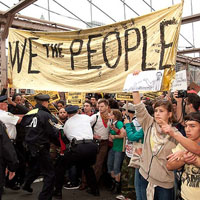
Rutgers Today: Why are they protesting, do they have a coherent message and what do they hope to achieve?
Livingston: They're protesting because they see their country's future – what we used to call the American Dream – being slaughtered by the same people who brought us the Great Recession. Yes, they have a coherent message: They're against oligarchy, economic royalism, income inequality, and do-nothing government; they're for taxes on certain stock transactions, the reinstatement of Glass-Steagall, which separated investment commercial banking activities; public spending to address the unemployment crisis; and better financing for education, among many other things. They hope to achieve a more equitable, democratic America, one based on equal opportunity, not crony capitalism. This, our very own perestroika, could lead to real social and economic reform.
Rutgers Today: How do the Occupy Wall Street (OWS) protesters differ from those in the Tea

Livingston: In one sense they don't: Both movements are against the power of big bankers to determine America's future at the expense of the general welfare. For the Tea Party types, however, big banks and big government are two sides of the same coin. For the OWS, government as such isn't the enemy, and may well be a useful tool in restoring democracy and thus the American Dream.
Rutgers Today: Is this just a “moment in time” or will Occupy Wall Street continue to gain support and become a strong national/international movement?
Livingston: Historians are notoriously bad at predicting the future, but I'll venture this: OWS is a leaderless movement because the people who compose and support it elected Barack Obama to go in the direction they wanted, toward a more democratic country, a more perfect union. He orphaned them. Now they've regained their voice and their confidence, and will, I believe, prevail, because they know they're part of an international uprising against oligarchy in every shape and kind, whether political, economic – or both.
Rutgers Today: How likely is it that economic and social change will come out of these protests?
Livingston: When the New York Times’ editorial board endorses a rag-tag protest in lower Manhattan, while its two most popular and influential columnists (Paul Krugman and Thomas Friedman) compare Zuccotti Park to Tahrir Square, and when self-styled extremists like Rush Limbaugh and Ann Coulter compare OWS to fascists, you know the mainstream of opinion is going your way. That makes real change all the more likely.
Rutgers Today: Can Occupy Wall Street be compared to social movements of the past?
Livingston: The comparison to the Arab Spring in America is actually a good way of looking at the composition and consequences of contemporary social movements. Did the people who gathered in Beirut or Tunis or Tahrir Square have a plan, a program? Did they really believe they could bring down dictators whose powers were virtually unlimited? The same could be said about the rag-tag-army of unruly militias that left the American Revolution more or less leaderless until the war began. And then in 1989, there was the Velvet Revolution in the former Czechoslovakia, when those like human rights activist Václav Havel demanded the political restructuring of the government. A decade earlier Havel, who became the president of the country’s first noncommunist government, wrote The Power of the Powerless, which circulated throughout Eastern Europe, inspired solidarity in Poland, and landed him in jail. As Havel wrote: “The real background in the movements that gradually assume political significance does not usually consist of overtly political events or confrontations between different forces or concepts that are openly political. These movements, for the most part, originate elsewhere, in the far broader area of the 'pre-political.”
Media Contact: Robin Lally
732-932-7084, ext. 652